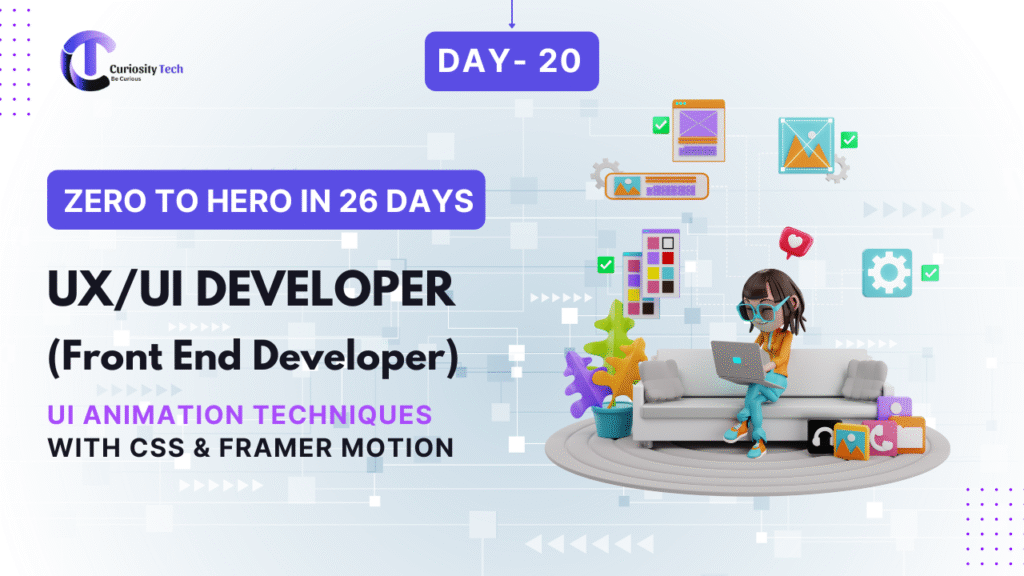UI/UX design has evolved at a breathtaking pace over the last decade, shaping not just how we interact with digital platforms but also how businesses engage with their audiences. As we approach 2025, the landscape of user experience is poised to become more intelligent, intuitive, and immersive than ever before. Designers and businesses alike need to be prepared for the trends that will define the future of UI/UX design, ensuring that their products remain not only relevant but truly human-centered.
At Curiosity Tech, we continuously observe these emerging trends to craft user experiences that are both innovative and practical. Based in Nagpur, we serve as a hub for creative minds who aim to revolutionize digital interactions, blending aesthetics, usability, and technology seamlessly.
1. AI-Driven Personalization
Artificial Intelligence is transforming UI/UX design by allowing interfaces to adapt dynamically to individual users. Personalized dashboards, predictive search results, and behavior-driven content are becoming the standard, rather than the exception. In 2025, expect AI to go beyond recommendations — interfaces will anticipate user needs in real-time, creating experiences that feel almost intuitive.
Example: Adaptive websites that rearrange menus and content based on user habits, such as e-commerce platforms showing personalized product layouts and adaptive pricing suggestions.
2. Voice & Gesture-Based Interfaces
With smart speakers, wearables, and AR devices becoming more prevalent, voice and gesture-based UI is poised to expand dramatically. By 2025, UI designers must account for non-traditional inputs to ensure smooth, accessible interactions.
Curiosity Tech has been experimenting with prototypes where users can navigate apps purely through voice commands or simple hand gestures, emphasizing accessibility and inclusivity.
3. Immersive AR/VR Experiences
Augmented Reality (AR) and Virtual Reality (VR) are no longer just gaming tools. They are quickly becoming integral to retail, education, healthcare, and entertainment sectors. UI/UX designers will need to craft experiences that feel natural in 3D spaces, considering depth, spatial navigation, and user comfort.
4. Micro-Interactions and Motion Design
Micro-interactions — subtle animations, feedback loops, and motion effects — continue to enhance user engagement. In 2025, these small gestures will be crucial in creating delightful experiences, helping users navigate interfaces without friction.
Example: Animated buttons that respond differently to long-press vs. tap, or interactive scroll effects that guide user attention without overwhelming them.
5. Ethical & Inclusive Design
Future UI/UX is not just about aesthetics; it’s about responsibility. Ethical design practices will focus on accessibility, inclusivity, and transparency. Designers must ensure that experiences are usable for everyone, including those with disabilities, while safeguarding user data and avoiding dark patterns.
6. Neumorphism and Minimalism Fusion
While minimalism has been a trend for years, 2025 sees it merging with neumorphism — soft, tactile interfaces that mimic real-world objects. This combination creates interfaces that are both visually appealing and intuitive, making users feel more connected to digital environments.

7. Sustainable & Performance-Optimized UX
Users are increasingly sensitive to performance and sustainability. UI/UX designs in 2025 will prioritize faster loading times, efficient code, and eco-friendly design principles. Lightweight interfaces with smart caching and progressive enhancements will be critical in maintaining user satisfaction across devices.
Why Staying Ahead Matters
For businesses and designers, staying ahead of these trends isn’t optional. It’s a competitive necessity. Curiosity Tech leverages these insights to help clients create products that are not only visually stunning but also deeply engaging and forward-thinking. From ideation to implementation, we ensure that every interface reflects the latest in design trends and technology.

Conclusion
The future of UI/UX design in 2025 promises experiences that are personalized, immersive, and ethically responsible. As technology advances, designers must embrace AI, AR/VR, voice interfaces, and micro-interactions while keeping accessibility and sustainability at the forefront. By understanding these trends and integrating them thoughtfully, businesses can create digital experiences that delight users, build loyalty, and stand out in an increasingly crowded digital landscape.



